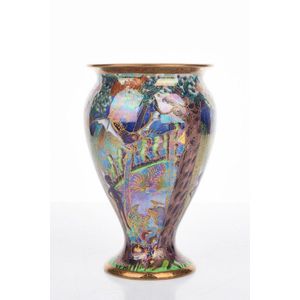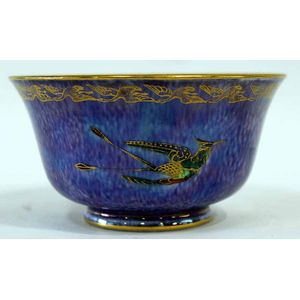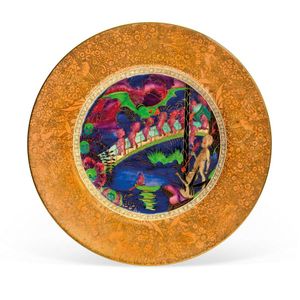
Wedgwood Fairyland Lustre Porcelain Wine Cup, English c. 1920-30
A small Wedgwood fairyland type lustre porcelain wine cup, English circa 1920-30. Dimensions: 6.1 cm diameter 4 cm high

Fairyland Lustre Vase by Daisy Makeig-Jones, c. 1925-1930
Wedgwood, Fairyland lustre vase, c. 1925-1930, by daisy Makeig-Jones, the exterior decorated with Woodland Elves, the interior with jumping fauns and elves to a sunset orange sky, restored crack (A/F), height 22.5 cm. Provenance: Private Collection, Sydney

Wedgwood Fairyland Lustre 'Fairy Gondola' Lily Tray, circa 1920
A Wedgwood Fairyland lustre 'Fairy Gondola' pattern 'Lily Tray', designed by Susannah Margaretta 'Daisy' Makeig-Jones, circa 1920, circular with an everted rim, the interior decorated with elves and fairies in a wooded landscape with gondolas in a river…

Wedgwood Fairyland Lustreware Bowl, 16 cm Diameter
A Wedgwood lustreware 'Fairyland' bowl, diameter 16 cm

Wedgwood Fairyland Lustre Bowl by Daisy Makeig-Jones
A Wedgwood Fairyland lustre large bowl by daisy Makeig-Jones, octagonal, decorated in the Firbolgs pattern to exterior, and Thumbelina to interior. Printed marks, c.1920. Dia.23 cm

Wedgwood Fairyland Trumpet Vase by Daisy Maekeig Jones
A Wedgwood Fairyland trumpet vase by daisy Maekeig Jones, height 15.5 cm

Wedgwood Fairyland Lustre Vase, c1925
A Wedgwood 'Fairyland' lustre vase, probably after a design by Makeig Jones, c1925, height 17.5 cm

Wedgwood Fairyland Lustre Vase in Torches Pattern
Superb Wedgwood Fairyland lustre vase cylindrical form with circular spreading foot, decorated in the 'Torches' pattern. Designed by daisy Makeig-Jones, c1925 (1881-1945), 29 cm height

Wedgwood Fairyland Lustre Vase by Daisy Makeig-Jones (1920)
Wedgwood 'Fairyland' orange lustre vase by daisy Makeig-Jones, circa 1920, stamped 'Wedgwood, made in England' with pictorial urn mark, 25 cm high

Wedgwood Fairyland Lustre Vase with Jewelled Tree & Animals
Good Wedgwood 'Jewelled Tree With Cat and Mouse' Fairyland lustre vase, c.1925, with a short neck above a tapering baluster body, beautifully decorated with fairies, pixies, cat, mouse, mushrooms and tree, in an orange enamel and gilt on a bronze lustre…

Wedgwood Fairyland Magic Imps and Fairies Plate
A Wedgwood limited edition 'Fairyland Magic' cabinet plate, titled 'Imps and Fairies on a bridge and Treehouse' and editioned 566a to the back, printed factory marks, 20 cm diameter

Wedgwood Fairyland Lustre Bowl by Daisy Makeig-Jones
A large octagonal Wedgwood Fairyland lustre bowl by daisy Makeig-Jones, c.1920, the interior decorated with 'Woodland Elves VIII - boxing Match', the exterior with panels of 'Castle on a Road' framed by a cobble border. Factory marks and pattern number…

Wedgwood Fairyland Lustre Plate with Pixies Crossing Bridge
Wedgwood Fairyland lustre plate, painted with pixies crossing a bridge within orange border, (three rim chips and slight rubbing to interior frame rim) 26.5 cm dia

Wedgwood Fairyland Lustre Vase with Figure and Elves
Wedgwood Fairyland lustre 'Candlemas' vase, designed by daisy Makeig Jones c1920s, ovoid form decorated with 3 panels depicting a tall figure with halo and 3 panels of climbing elves 27 cm height (restored but showing visible hairline cracks)

Wedgwood Fairyland Imps Plate
Wedgwood Fairyland lustre 'Imps on a Bridge' pattern plate by daisy Makeig Jones, circa 1930, stamped 'Wedgwood, made in England, 27 cm diameter

Wedgwood Fairyland Lustre Bowl with Firblogs and Thumberlina Frogs
Large Wedgwood fairyland lustre bowl of round form. Firblogs pattern to exterior and Thumberlina Frogs to the interior. 23.5 cm across, 11 cm high

Wedgwood Fairyland Lustreware and Bursley Ware Dragon Bowl
A Wedgwood Fairyland Lustreware, the exterior in blue lustre with phoenix decoration, the interior mottled orange with stylised gilt decoration at rim and phoenix to base. 1920-1930. Pattern Z2644. Together with a Bursley Ware 'Dragon' octagonal low bowl.…

Wedgwood Fairyland Lustre Bird Bowl (10cm)
Wedgwood Fairyland lustre bird small bowl, diameter 10 cm

Wedgwood Fairyland Octagonal Lustre Bowl
A Wedgwood Fairyland octagonal lustre bowl, outside moorish pattern against a black background orange crimson columns support curved arches and vaults, red and violet tones. Inside: smoke ribbon pattern, black columns hold aloft stylised leaves and…

Wedgwood Sunset Fairyland Lustre Vase with Imps Design
A rare and important Wedgwood Sunset Fairyland lustre vase, with 'imps on a bridge' design. Gilt 'raised bead' around foot and inside rim. 'Vase 2351' shape 175. Wedgwood, Portland vase mark 25481, factory mark, circa 1925, height 23 cm. Literature: Una…

Wedgwood Fairyland Lustre Empire Bowl with Elves Design
A Wedgwood flambe Fairyland lustre 'Leap Frogging Elves' design Empire shaped bowl, inside 'Elves on a Branch' design. Cobbie bead borders around the foot inside and outside ring. Wedgwood Portland vase mark, England. 25360, circa 1925, height 7 cm,…

Wedgwood Fairyland Lustre Octagonal Bowl with Pixies and Toadstools
A Wedgwood Fairyland 'Castle on a Rock' panelled octagonal lustre bowl, Trentham bad borders. Inside: Pixies on toadstools, Portland vase mark, England, Z5125/H, circa 1925, height 5.5 cm, diameter 8.5 cm. Literature: Una Des Fontaines, Wedgwood Fairyland…

Wedgwood Fairyland Lustre 'Woodland Bridge' Commemorative Bowl
A commemorative Wedgwood Fairyland Lustre 'Woodland Bridge' bowl, octagonal form, decorated in the Woodland Bridge pattern to both interior and exterior with lustre finish, the base with gilt printed detail 'Fairyland Lustre Woodland Bridge, Based upon an…

Fairyland Lustre Bowl by Wedgwood, 1930
Wedgwood fairyland lustre bowl exterior pattern woodland bridge, and the interior pattern picnic by the river, designed by Daisy Makeig-Jones, circa 1930, diameter 16.5 cm

Wedgwood Fairyland Limited Edition Cabinet Plate
Wedgwood Fairyland cabinet plate, limited edition no. 1A, 20.5 cm diameter approx.

Dragon Lustre Vase by Wedgwood
Wedgwood Fairyland lustre vase, with dragon decoration, 22.5 cm high approx.

"FairyLand Roc Centre" Plate by Wedgwood
Wedgwood 'FairyLand' lustre plate called the Roc centre variation, this magical scene is populated by maroon imps crossing a bridge with brown elves watching on while a green Roc bird flies above the imps between the violet sky and deep sapphire water.…

Wedgwood Fairyland Goblins Vase by Daisy Makeig-Jones
A Wedgwood Fairyland lustre 'Goblins' vase, designed by Daisy Makeig-Jones. 19 cm high

Wedgwood Fairyland Lustre Vase with Tree Serpent Decoration
Rare Wedgwood 'Fairyland' Lustre vase with Tree Serpent decoration designed by Daisy Makeig-Jones, 32 cm in height

Wedgwood Fairyland Geisha Lustre Bowl
A Wedgwood 'Fairyland' lustre octagonal bowl, circa 1920, decorated in the 'Geisha' pattern by Daisy Mekeig-Jones, stamped Wedgwood England, 8 cm high, 16 cm across

Wedgwood Fairyland Lustre Fruitbowl, Gardens of Paradise Pattern
A Wedgwood 'Fairyland' lustre fruitbowl, circa 1920, decorated in the 'Gardens of Paradise' pattern by Daisy Mekeig-Jones, stamped Wedgwood England, 28 cm diameter

Rare Wedgwood Fairy Land Lustre Wall Plaque
A rare Wedgwood 'Fairy Land' lustre framed wall plaque, all details to rear

Wedgwood Fairyland Lustre Malfrey Pot and Cover
A Rare Wedgwood fairyland lustre 'Ghostly Wood' malfrey pot and cover, designed by Daisy Makeig-Jones, circa 1920, the vase is inspired by the The Legends of Croquemitaine by Gustave Dore and other tales. The cover is painted with the Owls of Wisdom, Roc…

Wedgwood Fairyland Lustre Candlemas Vase by Daisy Makeig-Jones
A Wedgwood fairyland lustre 'Candlemas' ovoid vase, designed by Daisy Makeig-Jones, circa 1920, the sides of the vase decorated with arched black lustre panels of candle figures in procession with fairyland figures, alternating with pale blue lustre bands…

Wedgwood Fairyland Lustre Lily Tray by Daisy Makeig-Jones
A Wedgwood fairyland lustre 'Gondola' lily tray designed by Daisy Makeig-Jones, circa 1918, the low bowl with everted lip and interior painted and printed with 'Fairy Gondola' pattern, depicting elves and fairies frolicking around a lily pond. the…

Wedgwood Fairyland Lustre Bowl, Daisy Makeig-Jones Design
A Wedgwood fairyland lustre bowl, designed by Daisy Makeig-Jones, circa 1925, of octagonal form, the interior decorated on a pearl lustre ground with Woodland Elves VII - Fairy in a Cage pattern, the exterior with black lustre ground and 'Leapfrogging…

Wedgwood Tree Serpent Vase by Daisy Makeig-Jones (1925)
A Wedgwood fairyland flame lustre 'Tree Serpent' vase, designed by Daisy Makeig-Jones, circa 1925, depicting the tree serpent wound around a tree amongst mythical creatures and a pale yellow baby calmly seated at the base of the tree, shape no. 3150,…

Wedgwood Fairyland Lustre Plate by Daisy Makeig-Jones
A Wedgwood Fairyland lustre 'Roc centre' plate designed by Daisy Makeig-Jones, circa 1925, the Imps on the Bridge and surrounds printed, painted and enamelled in polychrome colours, the rim printed in gold with a 'Twyford' border on pale apricot ground,…

Wedgwood Flame Fairyland Lustre Bowl - Impish Elves Design
A Wedgwood 'Flame Fairyland' lustre bowl, mid 1920s, pattern Z5360, 'Leapfrogging Elves' design, the ogee style bowl with a continuous design of impish figures and fairies upon a vibrant mottled green ground against a graduating flame and amber star…

Wedgwood Fairyland Lustre Bowl with Spiderwebs and Bees
A Daisy Makeig-Jones Wedgwood Fairyland lustre bowl decorated with spiderwebs and bees, Dear Earl, size: 10.5 cm high, 23 cm diameter cm, weight: 0.863 kg, no visible cracks, chips or wear to the paint. In good condition.

Fairyland Lustre Trumpet Vase - 25 cm Height
Wedgwood Fairyland lustre trumpet vase, height 25 cm approx.

Wedgwood Fairyland Lustre Bowl by Daisy Makeig-Jones
Daisy Makeig-Jones for Wedgwood Fairyland lustre bowl, circa 1920, the exterior painted with 'Woodland Bridge' the interior with 'Picnic River' marked, Z4968 T, 20 cm diameter x 8.8 high

English Nursery Ware Porcelain Collection
A group of seven pieces of English Nursery Ware porcelain, various makers including a 'Bunnykins' plate and bowl by Royal Doulton, a Wedgwood 'Peter rabbit' plate, a 'Dizzy Ducklings' plate and saucer by Hanley N.S pottery, and a Winterton 'Buttercup…

Octagonal Fairyland Lustre Bowl with Butterfly Decoration
Wedgwood fairyland lustre bowl. Octagonal shape with butterfly decoration. 6 cm high, 15 cm wide.

Butterfly Fairyland Lustre Bowl
Wedgwood fairyland lustre bowl, the interior with butterfly decoration, the exterior magenta with gilt butterflies. 5 cm high.

Wedgwood Fairyland Lustre Bowl - Woodlands and Fairy Hat
Wedgwood fairyland lustre bowl interior pattern 'fairy with large hat', exterior 'woodlands'. Diameter 16.5 cm and 8 cm high. Excellent Condition

Wedgwood Fairyland Lustre Malfrey Pot & Cover
A Wedgwood Fairyland lustre Malfrey pot and cover of elongated ovoid form decorated with small imps and fairies on a gilt blue and black ground factory mark Z5157, 23 cm high

Wedgwood Fairyland Butterfly Lustre Bowl
Wedgwood Fairyland lustre small bowl. Butterfly decoration to interior. Height 5 cm. Diameter 7 cm

Wedgwood Fairyland Lustre Ginger Jar Lamp Base
A large Wedgwood Fairyland lustre ginger jar converted to lamp base,'Ghostly Wood', circa 1920, ovoid with high domed cover decorated with a woodland scene of fairies, ghosts and goblins on multi iridescent grounds, later converted to a lamp base with…



 Loading more...
Loading more...